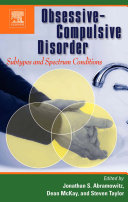Obsessive-Compulsive Disorder: Subtypes and Spectrum Conditions
| Series: | |
| Publisher: | Elsevier Science |
| Subject: | Obsessive-compulsive disorder |
| Authors: | Jonathan S Abramowitz , Dean McKay , Steven Taylor |
| Pages: | 313 pages |
| Binding: | Hardcover |
| ISBN: | 9780080447018 |
| Call No: | RC 533. O14 2008 |
The proper diagnostic definition of Obsessive Compulsive Disorder (OCD) has been hotly debated in research and academic communities. There are those who believe true OCD manifests by both obsessions and compulsions, and others who believe OCD is a continuum that may include the presence of only obsessions or only compulsions as part of an Obsessive Compulsive Spectrum Disorder. The debate is not just academic, as it relates to how these disorders may originate, and how they may best be treated. Obsessive-Compulsive Disorder: Subtypes and Spectrum Conditions explores these debates, summarizing the evidence base behind each question, with a conclusion as to how this disorder is best defined going forward, and the conclusions to be drawn in relation to treatment.
Divided into two sections, part 1 addresses the heterogeneity of OCD, exploring the concept of content specific subtypes, and the evidence to support such a typology. Each chapter here critically reviews the literature with respect to symptomatology, empirically supported etiologic and conceptual models, support for the symptom presentation as a valid OCD subtype, and a review of subtype-specific treatment literature. These subtypes include contamination and decontamination, doubting and compulsive checking, and symmetry-order and arranging. Part 1 additionally explores compulsive hoarding, tic-related OCD, and autogenous and reactive obsessions.
Part 2 explores Obsessive Compulsive Spectrum Disorders (OCS), including trichotillomania, gambling, body dysmorphic disorder, hypochondriasis, tic disorders and Tourette syndrome, eating disorders, obsessive compulsive personality, and compulsive sexual behavior. For each disorder, chapters review the clinical presentation, etiologic and conceptual models, the empirical evidence pertaining to the disorder's standing as an OCS condition, and the ramifications for treatment. Concluding chapters in both sections summarize the evidence toward a recommendation of how OCD is conceptualized for diagnostic and treatment purposes going forward.

